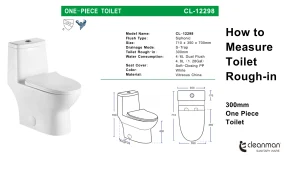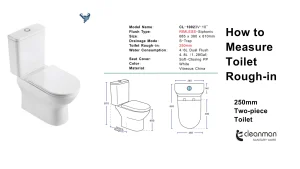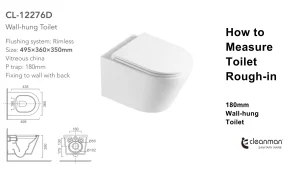🚽 Introduction: Why Toilet Rough-In Matters
If you’re planning to replace an old toilet or install a new one, there’s one critical measurement you can’t afford to get wrong: the toilet rough-in.
The rough-in refers to the distance between the wall and the center of your toilet’s drainpipe or bolts that hold the toilet in place. This measurement determines whether your new toilet will fit your bathroom plumbing layout without the need for costly rework or adjustment.
Toilet rough-in sizes vary by country, toilet type, and installation method (floor-mounted vs wall-hung). While some regions use inch-based rough-ins such as 10″, 12″, or 14″, others—especially in Asia and Europe—use millimeter-based measurements like 180mm, 220mm, 250mm, or 300mm.
Before purchasing or installing a toilet, always confirm the rough-in distance to ensure proper fit with your drainage system. Choosing a toilet that doesn’t match your rough-in can lead to:
-
Toilets that don’t align with the wall
-
Leaky seals or misaligned flanges
- Or in some cases, a completely unusable toilet
In this guide, we’ll walk you through:
-
What “toilet rough-in” actually means
-
How to measure it accurately (even if your old toilet is still installed)
-
The different types of toilets and their rough-in needs
-
What to do if your bathroom doesn’t match standard sizes
-
Plus, common mistakes to avoid
Whether you’re a DIY enthusiast, a contractor, or a homeowner just trying to get it right, this guide is your go-to resource for everything related to toilet rough-in measurements.
🔧 Let’s get started—because one wrong inch can flush your entire project down the drain.

📏 What Is a Toilet Rough-In?
In simple terms, the toilet rough-in is the distance from the finished wall behind the toilet to the center of the toilet flange (the circular pipe fitting on the floor where the toilet bolts down). If the toilet is already installed, you can measure from the wall to the center of the rear bolt cap.
This measurement ensures that:
-
The toilet fits snugly against the wall
-
The flange lines up with the waste outlet
-
You don’t end up with unnecessary gaps or misalignment
🧠 Why It Matters:
-
Toilets are manufactured for specific rough-in distances (usually 10″, 12″, or 14″)
-
A mismatch could mean the toilet won’t fit at all—or will sit too far from the wall
-
Some compact or wall-hung models require different measurements
To get your project right the first time, always confirm your rough-in before purchasing a new toilet.
🛠️ Tools You Need to Measure Toilet Rough-In
Here’s what you’ll need for a successful measurement:
-
Tape measure (preferably metal for accuracy)
-
Notebook or phone (to mark down the size)
-
Flashlight (if the light is dim)
-
Optional: Straight edge or level to check alignment
Important: Always measure from the finished wall, not the baseboard. If your wall isn’t finished yet, subtract the thickness of drywall or tile.
📐 Step-by-Step: How to Measure Toilet Rough-In
✅ If the Toilet is Already Installed:
-
Locate the bolt caps at the base of the toilet.
-
Measure from the finished wall directly behind the toilet to the center of one bolt cap.
-
Ignore baseboards—measure only from the finished surface.
-
Measure in inches and round it down to the nearest standard (10″, 12″, 14″).
Tip: If the tank is curved, estimate the center or remove the toilet to measure precisely.
✅ If the Toilet Has Been Removed:
-
Identify the toilet flange on the floor (center of the waste pipe).
-
Measure from the finished wall to the center of the flange opening.
-
Note the rough-in in inches.
This is the most accurate method and ideal during renovations or new construction.
📊 Standard Toilet Rough-In Sizes Explained
🔢 Common Sizes:
-
12 inches – The most common and widely available option
-
10 inches – Found in older homes or compact bathrooms
-
14 inches – Less common, often in older construction
Most toilets are made to fit a 12-inch rough-in, so finding 10″ or 14″ toilets may require special ordering or selecting specific product lines (which Cleanman offers).
📊 Rough-In Conversion Table
| Type | inch | mm | Application |
| Wall-hung/ Two Piece Toilet/ Floor Standing Toilet | 7.1″ | 180 mm | Mostly Europe and Asia |
| Floor-mounted one-piece toilet | 9.8″ | 250 mm | Some Asian countries |
| Floor-mounted one-piece toilet | 11.8″ | 300 mm | Mostly North American and Asian Countries |
| Floor-mounted one-piece toilet | 8.7″ | 220 mm | Mostly Indian and African Area |
🚽 Measuring Rough-In for Different Toilet Types
🔸 One-Piece and Two-Piece Toilets
These measure the same way, but one-piece toilets often have a bulkier design that may affect fit against the wall. Always check both rough-in and tank depth.
🔸 Wall-Mounted Toilets
These require a different approach:
-
Measure from floor to outlet height if wall-drain
-
Confirm carrier frame rough-in specs
-
Check compatibility with in-wall tanks
Wall-mounted systems like Cleanman’s rear-outlet models are great for tight spaces but require precise rough-in planning.

🔸 Corner Toilets
Corner-installed toilets may still follow a 12″ rough-in but need diagonal measurement planning. Always consult product-specific specs.
🧩 What If Your Rough-In Isn’t Standard?
🔧 Common Challenges:
-
You measure 11.5″—should you go with a 12″ or a 10″ toilet?
-
You have a tight space but only find 12″ models
-
Your new toilet is flush with the wall but doesn’t align with bolts
🛠 Solutions:
-
Offset flanges can adjust the rough-in by ~2 inches
-
Purchase a 10″ or 14″ rough-in model (Cleanman offers both)
-
Relocate the flange (only in major renovations)
Offset flanges are the easiest fix if you’re not ready to cut into your flooring or concrete slab.
🛒 Choosing a Toilet Based on Your Rough-In
Here’s a practical checklist when selecting your new toilet:
-
✅ Check your measured rough-in
-
✅ Review the spec sheet of any toilet you’re considering
-
✅ Look at the “from wall to bolt center” line in tech drawings
-
✅ Ask your supplier or consult Cleanman’s labeled products
💡 Cleanman provides clearly labeled rough-in sizes on all spec sheets and packaging. View options at www.cleanman-cn.com
❓ Frequently Asked Questions (Toilet Rough-In)
Q: Can I install a 12” toilet in a 10” rough-in space?
A: Not directly. You’d need an offset flange, or the toilet will sit away from the wall—or not fit at all.
Q: How do I measure rough-in if the toilet is still installed?
A: Measure from the wall (not baseboard) to the center of one bolt cap on the base.
Q: Can I move the toilet flange to change my rough-in?
A: Yes, but it involves major plumbing work. Only recommended during renovations.
Q: How far should the toilet be from the wall?
A: If installed correctly for its rough-in, the tank should sit about ½ to 1 inch from the wall.
Q: Does the seat height or bowl shape affect rough-in?
A: No. Seat height and shape (round vs elongated) impact comfort—not flange alignment.

⚠️ Common Mistakes to Avoid
-
❌ Assuming all toilets are 12” rough-in by default
-
❌ Forgetting to check for tank clearance with thick walls or tiles
-
❌ Not verifying the toilet’s spec sheet dimensions before purchase
🧼 Cleanman Toilet Solutions by Rough-In Size
At Cleanman, we manufacture a full range of toilets to fit:
-
🔵 10-inch rough-in: Ideal for compact and older homes
-
⚪ 12-inch rough-in: Standard fit for 90% of installations
-
🟣 14-inch rough-in: Specialty fit with extended tanks
-
🟡 Wall-mounted systems: Rear outlet + concealed tank options
Every toilet comes with detailed spec sheets, installation instructions, and support videos. → Explore Cleanman Toilet Models. → Explore Smart Toilet Models by Cleanman
✅ Final Thoughts: Get the Rough-In Right the First Time
Measuring your toilet rough-in is one of the simplest yet most important steps before purchasing a new toilet.
By taking 5 minutes to measure from the wall to the center of your bolts or flange, you could avoid:
-
Costly installation mistakes
-
Return hassles
-
Improper fit and leaks
Whether you’re upgrading for style, comfort, or water efficiency, knowing your rough-in ensures the new toilet you choose will work perfectly the first time.
Have more questions or need help choosing a toilet? 📩 Contact the Cleanman support team or browse our full collection: cleanman-cn.com


